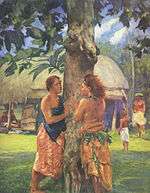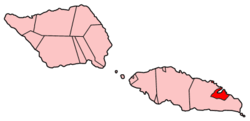Fagaloa Bay
Fagaloa Bay is located on the north eastern coast of Upolu island in Samoa. The area is a significant region of conservation and culture. The bay is situated within the political district of Va'a-o-Fonoti.


Geography
The geographic area consists of a mountain formation rising out of the sea. At the base of the bay lies the village Ta'elefaga at the mouth of the Malata river. To the east above the villages of Lona and Uafato are several waterfalls by mountain forests. On the western side is Mount Fao with spurs dissolving seaward into cliffs called Utuloa. Further east lies Uafato Bay at the eastern base of Malata river which displays spectacular landscape of lush rainforest and waterfalls.
History
The distinctive features of the Fagaloa area portrays some of the most interesting myths and legends in Samoan mythology which are considered invaluable and relevant to the peoples' cultural lifestyle.
During the war against Samalaulu for the Kingship of Samoa, Fonoti defeated Samaluulu and was made King of Samoa and ruled from his residence at Falefa. In return for the services rendered, King Fonoti granted Ulualofaiga rulership over the Fagaloa District as well as giving Ulualofaiga the village of Amanave in Tutuila. Among the many titles the King gave to those who helped him defeat Samalaulu's forces, he also gave Faleapuna and Fagaloa the title Vaa-o-fonoti in recognition of their skilled naval fleets who defeated Aiga i Le Tai at sea. These titles distinguishes the Districts down to the present day.
Villages
Situated at Fagaloa Bay are the villages of Sauano, Saletele, Musumusu, Salimu, Ta'elefaga, Maasina, Lona, Samamea and Uafato.[1]
Conservation
The area Fagaloa Bay - Uafato Tiavea Conservation Zone includes native forests and bird life earmarked for Unesco's world heritage protection.
See also
- Samoan language
- Fa'amatai, chiefly system of governance in the Samoa Islands
References
- "Fagaloa Bay - Uafato Tiavea Conservation Zone". UNESCO World Heritage. Retrieved 10 November 2009.
